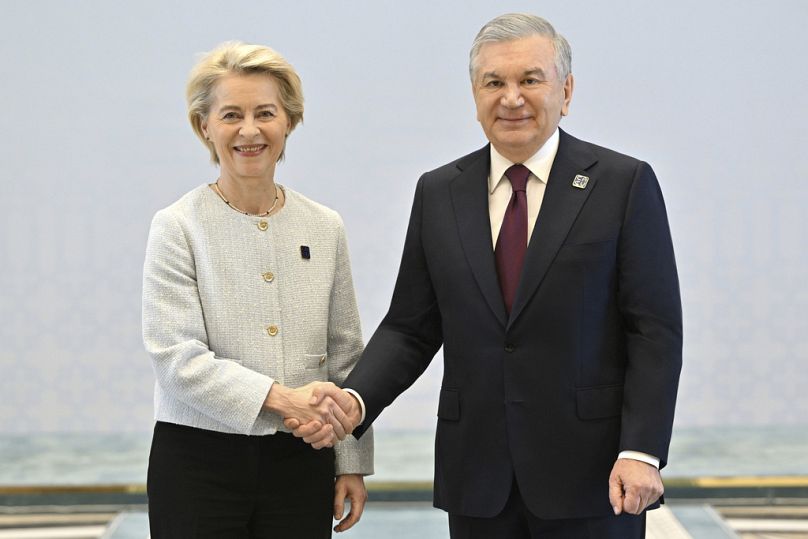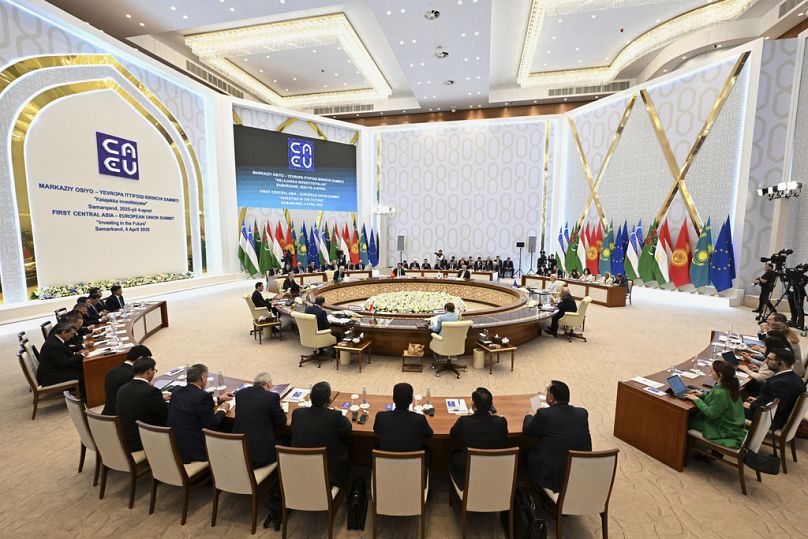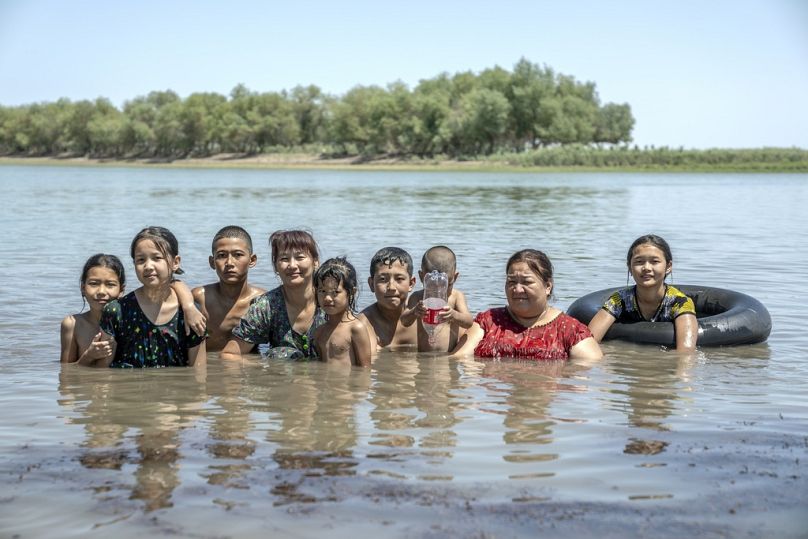Delegates at the Samarkand Climate Forum were informed that Central Asia has been experiencing increasing temperatures annually, leading to water scarcity and, as a result, food shortages.
The Climate Forum, held annually as a recurring event, served as a continuation of the Central Asia-European Union Summit. This summit raised the collaboration between the European Union and the Central Asian region to a strategic level.
The attendees were all top-tier individuals: they included the heads of state from five nations in Central Asia as well as the leaders of the European Council and European Commission.
In the prior gathering, where they had talked about collaboration and funding for the green transformation and water management, the participants zeroed in on specific initiatives aimed at preventing Central Asia from turning into a desert.
At the opening of the forum, hosted by President of Uzbekistan Shavkat Mirziyoyev, he clearly outlined the challenges faced by Central Asia.
Climate change is inherently connected to food and energy security. Arable lands are diminishing quickly as the area's population expands, and within 25 years, this number could exceed 100 million inhabitants. Currently, more than 20% of the territory experiences land degradation. By the time a quarter-century has passed, agricultural output might drop by up to one-third.
Central Asian nations collaborating with the European Union
Regardless of how severe the threat may be, experts emphasize that collaborating with the European Union and its extensive initiatives aimed at food safety and technological advancement can enhance our chances in combating the climate crisis.
"I think it’s crucial for us to pool our scientific resources to boost the adaptability of our forestry and agricultural industries, along with enhancing food security under the HORIZON EUROPE program," stated President Shavkat Mirziyoyev of Uzbekistan.
Leaders from the EU, including President Antonio Costa of the European Council and President Ursula von der Leyen of the European Commission, not just concurred but also restated their dedication to the EU’s involvement. They highlighted that the EU is significantly engaged in addressing environmental challenges faced by Central Asia due to climate change.
"Today, Central Asia and Europe have decided to establish a new strategic alliance. This partnership will prioritize climate security and the preservation of natural environments. Initially, Europe aims to collaborate with you in adjusting to a shifting climate," stated EU Commission President Ursula von der Leyen.
Secondly, collectively we can accelerate the worldwide shift towards clean energy. As Von Der Leyen noted, last year saw Uzbekistan, Tajikistan, and Kyrgyzstan join the global commitment to doubling energy efficiency and tripling renewable energy capacity by 2030.
On his behalf, the President of the European Council, Antonio Costa, stated, "Today, alongside the President of the European Commission, Ursula von der Leyen, we confirm our dedication to upgrading the relationship between Central Asia and the European Union to a strategic partnership."
Forming a strategic alliance aimed at consolidating European assets, knowledge, and technological capabilities to foster enhanced collaboration with Central Asia regarding environmental initiatives, water stewardship, energy stability, eco-friendly progress, and sustainable practices—that is the path ahead. Such an initiative should form a key component of our shared tomorrow.
Addressing climate change in Central Asia
The European Union is already combating the impacts of climate change via development initiatives in the area.
For example, the EU is establishing a fresh greenbelt around the Aral Sea, reviving an area that has turned into a saline wasteland. This initiative assists Central Asian farmers in adjusting to decreasing rainfall by employing technologies designed for conserving water and tracking consumption efficiently.
This is similar to the transformation that numerous farmers within the European Union are currently experiencing. These European farmers are now investigating novel approaches, such as leveraging our satellites to track soil conditions and embracing new genomic technologies with climate-resilient crops.
At an industrial scale, the EU is committing resources to promote clean energy throughout this area, encompassing projects like the groundbreaking Rogun dam in Tajikistan and the Kambarata dam in Kyrgyzstan. These initiatives aim to produce sufficient power not just for these nations but also with the potential to be exported across Central Asia.
They plan to boost emerging strategic sectors, such as processing raw materials. Additionally, they aim to electrify our transportation routes—which we've discussed today—and generate clean hydrogen that might be exported.
This arrangement genuinely benefits all parties involved. It enhances our energy autonomy, improves our trading relationships, and naturally, it aids our shared Earth, contributing positively to climate efforts and the preservation of our natural environment," stated von der Leyen.
The heads of Uzbekistan, Kazakhstan, Tajikistan, Kyrgyzstan, and Turkmenistan outlined the initiatives and concepts that could profit from enhanced financial support and knowledge sharing.
Their initiatives varied from developing a local water management plan to planting millions of trees to combat desertification—a problem that Uzbekistan is currently addressing.
A number of meetings were held with different stakeholders, some of them warning that the alarm bells rang out too late but most of them leaving hopeful.
The key aspect to observe was the dedication from every country and their cooperation with the EU.
It is essential for the attendance of state leaders as well as the representation from the EU’s leadership and the developmental banks.
"It shows that the stakeholders are prepared to take action and are willing to collaborate," stated Anacláudia Rossbach, who serves as the executive director of UN-Habitat.
Few locations are as fitting for hosting an environmental awareness event as the Aral Sea.
This serves as a chilling illustration of how humans can transform their own living spaces. Formerly the fourth largest lake globally, it covered an expanse of 68,000 square kilometers and was once teeming with life.
Nourished by the waters of the Syr Darya and Amu Darya rivers, this area served as both a natural habitat for numerous wildlife species and provided sustenance for local fishermen, yielding an annual catch of 60,000 tons of fish. However, in 1960, the Soviet Union opted to transform the region into a major center for cotton cultivation.
Irrigating up to 7 million hectares of farmland consumed substantial amounts of water from the two rivers, causing the Aral Sea to shrink. Although both cotton cultivation and the Soviet Union have become relics of the past, the agricultural areas continue to expand, while the sea remains in a state of depletion.
When compared to its former state, the area has shrunk into a mere 8,000-square-kilometer pool where salt levels have risen dramatically, making it almost uninhabitable for most organisms. Throughout the entire region, water scarcity is widespread, with available resources diminishing progressively.
Just five years back, several nations within this area engaged in armed conflict over individual wells or small streams.
During the Samarkand Climate Forum, they gathered with EU officials and talked about collaborative initiatives aimed at preventing the catastrophe.
.png)


